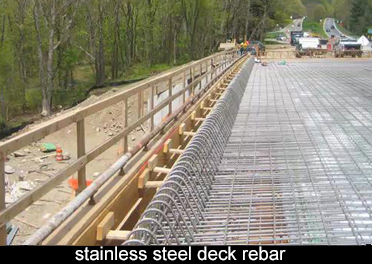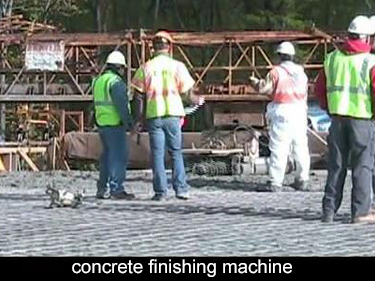Here's the morning after the steel erection. Three beams have been installed and I think that is excellent progress, considering this was their first night shift. When the first beam is erected, because it is so long and slender. It's considered unstable. The ends are braced, but an additional tower is provided to carry some of the dead load of the beam, and also to support the top flange and brace it against rotating. That made the first beam stable. After that, the second beam was raised and joined to the first beam by means of intermediate diaphragms. Then the pair of beams was stable, and subsequent beams could be erected and joined to the previous beam with intermediate diaphragms.
A lot of people use a figure of 15 minutes to set a steel beam, but that's completely unrealistic under these circumstances. It's time-consuming to set up the crane and then to dismantle the crane. I think three pieces per shift under these conditions are very good production.
 When all of the beams have been installed, you're ready to install the formwork. On the right side of this fascia beam, the forms are metal forms, stay-in-place forms. They span from beam to beam, and they're attached to the top flange by tack welding. On the left side of the fascia, the formwork is conventional wood formwork, supported by brackets. The brackets hang from the fascia beam, and you can see some of the supporting hardware here, which has also been tack welded. In the case of this hardware, the welding is done away from the edge of the beam. You need to check on requirements for permissible welding on these beams. The tack welding may be permissible, but more substantial welding has to be done off the edge of the flange.
When all of the beams have been installed, you're ready to install the formwork. On the right side of this fascia beam, the forms are metal forms, stay-in-place forms. They span from beam to beam, and they're attached to the top flange by tack welding. On the left side of the fascia, the formwork is conventional wood formwork, supported by brackets. The brackets hang from the fascia beam, and you can see some of the supporting hardware here, which has also been tack welded. In the case of this hardware, the welding is done away from the edge of the beam. You need to check on requirements for permissible welding on these beams. The tack welding may be permissible, but more substantial welding has to be done off the edge of the flange.
 When I first saw this deck rebar, I was taken aback. I thought it was galvanized, so I looked at it carefully where the ends had been cut. It was not galvanized. It certainly is not epoxy coated. When I inquired, I was told that it was stainless steel. I've never seen stainless steel rebar used on a construction site. This was a first. I don't know if the state had some poor experiences with the epoxy-coated rebar, or if they're simply exploring new materials to see if they will work equally well or better. I don't know the history of why they've selected stainless steel here. This is certainly a first.
When I first saw this deck rebar, I was taken aback. I thought it was galvanized, so I looked at it carefully where the ends had been cut. It was not galvanized. It certainly is not epoxy coated. When I inquired, I was told that it was stainless steel. I've never seen stainless steel rebar used on a construction site. This was a first. I don't know if the state had some poor experiences with the epoxy-coated rebar, or if they're simply exploring new materials to see if they will work equally well or better. I don't know the history of why they've selected stainless steel here. This is certainly a first.
The fascia form is made of wood, supported on brackets. You can also see this wood handrail, and on top of the fascia form, there's a screed pipe. That's supported on adjustable screws. You need to set this pipe at a higher elevation than the finished elevation to accommodate dead load deflections. You also should use the finishing machine to make passes over the rebar and make sure you're really achieving the correct cover over the rebar.
 I have a video showing the placement of the deck concrete, but I wanted to make some general observations first. You can see the finishing machine. The two operators on the left are standing on the finishing machine. Of course, it spans across the entire deck and runs on these mixed screeds. Behind the finishing machine, there's a rolling bridge, which carries these pre-wetted curing blankets. They are applied to the concrete immediately after its placed and screeded off.
I have a video showing the placement of the deck concrete, but I wanted to make some general observations first. You can see the finishing machine. The two operators on the left are standing on the finishing machine. Of course, it spans across the entire deck and runs on these mixed screeds. Behind the finishing machine, there's a rolling bridge, which carries these pre-wetted curing blankets. They are applied to the concrete immediately after its placed and screeded off.
You want to cover it as soon as possible to prevent the escape of any moisture, and especially in the summer, it's critical to get on it immediately. The requirement on this project is to keep that curing blanket moist for 14 days. You do that with perforated hose or sprinklers. The other observation, there's over a dozen people here, but most of them are bystanders. They are celebrating the day when they are finally pouring the bridge. It's been a troubled project and it must be a relief to everybody to finally see the bridge concrete being placed.
continue >